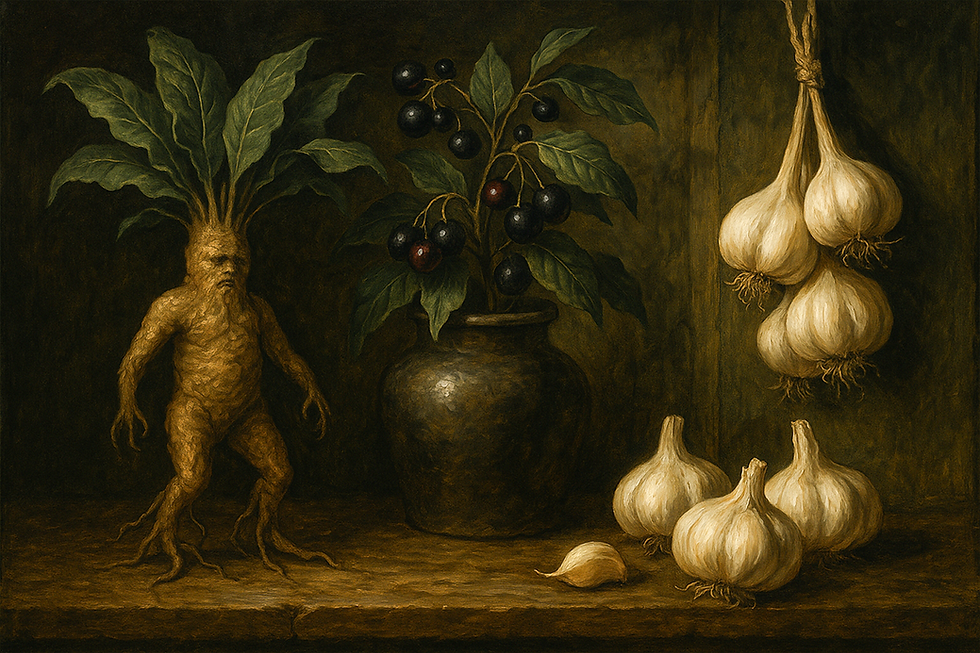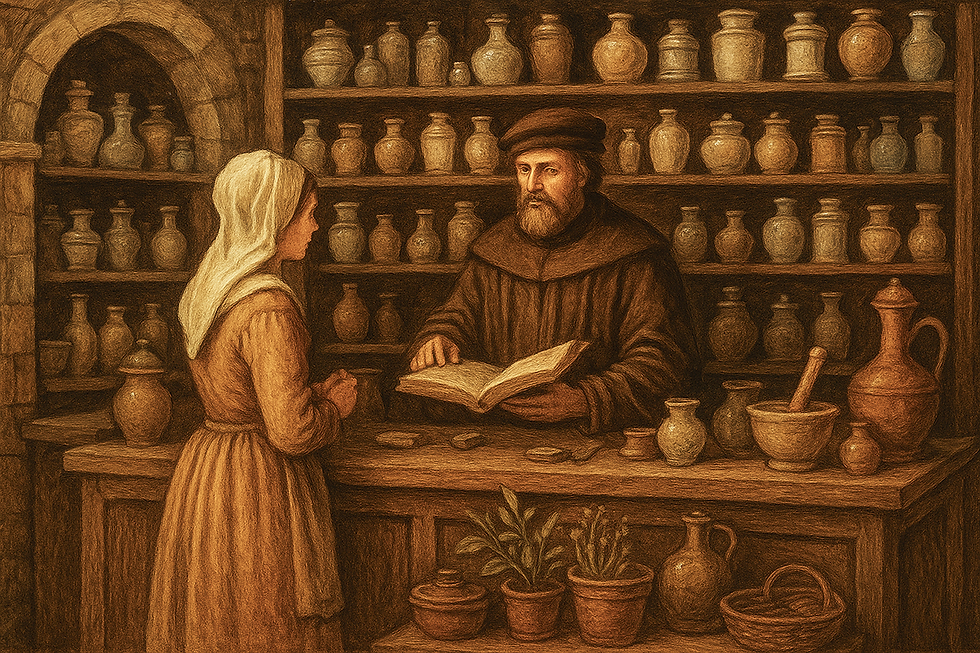Folk Medicine and Magic Plants: Mandrake, Belladonna, Garlic, and More
- Cătălina Ciobanu
- Sep 6
- 5 min read

For thousands of years, humans have turned to the natural world for healing, protection, and guidance. Among the herbs and plants that filled medieval gardens and apothecary shelves, some became more than just remedies — they became legends. In European folklore, plants like mandrake, belladonna, and garlic were not only medicines but also magical allies and dangerous poisons.
These plants stood at the crossroads of medicine, magic, and myth, embodying the fears and hopes of communities who saw the natural world as both a gift and a mystery. This article explores the stories and uses of some of the most famous magical plants in European folklore and beyond, revealing how they shaped both healing practices and supernatural beliefs.
Mandrake: The Root That Screams
Few plants in folklore are as mysterious as the mandrake (Mandragora officinarum). Native to the Mediterranean, it became famous in medieval Europe as a plant of powerful magic. The mandrake root often resembles the shape of a human body, with forked “legs” and “arms.” This likeness fueled the belief that the mandrake was alive, possessing a spirit. Medieval texts claimed that when uprooted, the mandrake would scream so loudly it could kill anyone who heard it. To avoid this fate, harvesters supposedly tied a dog to the root and let the animal pull it from the ground.
Despite its terrifying reputation, mandrake had medicinal uses. Ancient physicians used it as an anesthetic, painkiller, and even an aphrodisiac. However, the plant is highly toxic, containing hallucinogenic alkaloids that could induce visions or even death in large doses. In folklore, mandrake roots were also kept as talismans to bring wealth, fertility, or protection. Alchemists and magicians prized them as rare and powerful charms. The plant became so iconic that it even appears in literature, from Shakespeare to Harry Potter.
Belladonna: The Deadly Nightshade
The name belladonna means “beautiful lady” in Italian, a hint of the paradox it represents: beauty and death combined. Known as deadly nightshade (Atropa belladonna), this plant was both a poison and a cosmetic in European history.
During the Renaissance, women used belladonna juice to dilate their pupils, creating what was considered a seductive, doe-eyed look. Yet the same plant could kill with just a few berries. The toxins — atropine and scopolamine — affect the nervous system, causing hallucinations, delirium, and eventually death.
In folklore, belladonna was closely associated with witchcraft. Witches were said to use it in their “flying ointments,” hallucinogenic salves that induced visions of flight and spirit journeys. The plant’s intoxicating effects linked it to altered states of consciousness, making it both feared and revered. Doctors, however, also found uses for it. In controlled doses, belladonna was used as a painkiller, muscle relaxant, and treatment for eye conditions. The dual nature of belladonna — healer and killer — made it one of the most enigmatic plants of European folk medicine.
Garlic: The Protector Plant
Unlike mandrake and belladonna, garlic (Allium sativum) was not dangerous but rather a universal protector. Known since antiquity, garlic was believed to ward off disease, evil spirits, and even vampires. In folk medicine, garlic was used as a cure for infections, coughs, and wounds. Its antibacterial properties, confirmed by modern science, gave it real healing power. During epidemics, people wore garlands of garlic or rubbed it on doorways to keep away plague and evil.
Garlic’s role in vampire lore is particularly famous. In Eastern European traditions, garlic was placed in graves, hung in homes, or rubbed on the body to prevent attacks from the undead. Its pungent smell and association with purity made it a natural weapon against dark forces. Even today, garlic carries echoes of its magical reputation. It remains a symbol of protection and resilience, a reminder of how ordinary plants became extraordinary in folklore.
Other Plants of Magic and Medicine
Henbane (Hyoscyamus niger)
Like belladonna, henbane is part of the nightshade family and contains hallucinogenic toxins. In medieval Europe, it was used in potions, charms, and witchcraft. It was also an ingredient in early anesthetics. Folklore warned that it opened doors to madness and spirits.

Mandrake’s Cousins: Ginseng and Bryony
Plants with human-shaped roots, like ginseng in Asia or white bryony in Europe, often gained magical reputations similar to mandrake. They were thought to enhance vitality, fertility, and strength.
Mistletoe (Viscum album)
Sacred to the Druids, mistletoe was believed to have protective and healing powers. It was harvested with golden sickles in ritual ceremonies and later became part of European folklore as a charm of love and luck.
Sage and Rosemary
While not deadly, herbs like sage and rosemary carried magical reputations as purifiers. Burning sage was believed to drive away evil, while rosemary protected households and was placed in coffins to safeguard souls.
Folk Medicine and the Blurring of Science and Magic
In medieval and early modern Europe, the line between medicine and magic was thin. Physicians, herbalists, and wise women often used the same plants, combining practical remedies with charms, prayers, and rituals. A potion for healing might include herbs known for real medicinal effects, alongside words or symbols meant to invoke divine or supernatural aid.
This blending of worlds gave rise to suspicion. Women who practiced healing outside official medicine were often accused of witchcraft, especially if their remedies worked too well or too mysteriously. The very plants that could save lives — mandrake, belladonna, henbane — were also associated with witches’ brews and diabolical pacts.
Why Magic Plants Still Fascinate Us
Even today, the plants of folklore capture our imagination. Mandrake and belladonna appear in fantasy novels and films. Garlic remains a symbol of strength and protection. Scientific research continues to reveal the chemical compounds that gave these plants their effects — proof that folklore often contained kernels of truth. These plants remind us of a time when the natural world was alive with mystery, when every root or herb might be both cure and curse. Folk medicine was never just about health; it was about navigating a world where the boundaries between nature, spirit, and magic were porous.
Between Cure and Curse
The story of mandrake, belladonna, garlic, and their companions is the story of how humans sought healing and protection in a dangerous world. They embody the paradox of folk medicine: plants could save lives, but also take them; they could heal the body, but also touch the soul.
In folklore, plants were never just plants. They were protectors, tricksters, and teachers, reminding us that the natural world carries both danger and wonder. To study them is to glimpse the deep roots of human belief, where medicine and magic were inseparable.




Comments